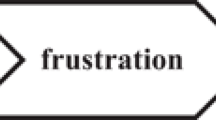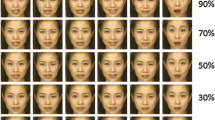To provide insight into what aspects of the emotional circuit might be affected in high-functioning autism, we measured indices of physiological emotions and of the expression of conscious feelings in 10 children with high-functioning autism or Asperger syndrome and 10 comparison participants. Pleasant, unpleasant, and neutral pictures were presented while skin conductance responses were measured. Self-report ratings of pleasantness and interestingness were taken between pictures. Skin conductance responses did not differ between the groups. Self report ratings were different, with the children with autism giving more similar answers to the two questions than the comparison children. Impairments in socio-emotional expression in autism may be related to deficits in perception and/or expression of conscious feelings; physiological emotions may be relatively preserved.


Similar content being viewed by others
References
American Psychiatric Association. (1994). Diagnostic and statistical manual of mental disorders (4th ed.). Washington, DC:Author
Blair R. J. R., (1999). Psychophysiological responsiveness to the distress of others in children with autism Personality and Individual Differences 26: 477–485
Celani G., Battacchi M. W., Arcidiacono L., (1999). The understanding of the emotional meaning of facial expressions in people with autism Journal of Autism and Developmental Disorders 29: 57–66
Lang J. P., Greenwald M. K., (1988). The international affective picture system standardization procedure and results for affective judgments: Technical report 1B. Gainesville FL: Center for Research in Psychophysiology, University of Florida
Lang J. P., Ohman A., Vaitl D., (1988). The international affective picture system [photographic slides]. Gainsville FL: Center for Research in Psychophysiology, University of Florida
LeDoux J., (1996). The emotional brain. New York, NY: Simon and Schuster
Leekam, S. (2005). Why do children with autism have a joint attention impairment? In N. Eilan, C. Hoerl, T. McCormack, & J. Roessler (Eds.), Joint attention: Communication and other minds. Oxford: Oxford University Press
Lord C., Risi S., Lambrecht L., Cook E. H. Jr, Leventhal B. L., DiLavore P. C., Pickles A., Rutter M., (2000). The autism diagnostic observation schedule-generic: a standard measure of social and communication deficits associated with the spectrum of autism Journal of Autism and Developmental Disorders 30: 205–223
Lord C., Rutter M., Le Couteur A., (1994). Autism Diagnostic Interview-Revised: a revised version of a diagnostic interview for caregivers of individuals with possible pervasive developmental disorders Journal of Autism and Developmental Disorders 24: 659–685
Ozonoff S., Pennington B. F., Rogers S. J., (1991). Executive function deficits in high-functioning autistic individuals: relationship to theory of mind Journal of Child Psychology and Psychiatry 32: 1081–1105
Spangler G., Grossmann K. E., (1993). Biobehavioral organization in securely and insecurely attached infants Child Development 64: 1439–1450
Wechsler D., (1991). Wechsler intelligence scales for children-III. San Antonio, TX: The Psychological Corporation
Welner Z., Reich W., Herjanic B., Jung K. G., Amado H., (1987). Reliability, validity, and parent–child agreement studies of the diagnostic interview for children and adolescents (DICA) Journal of the American Academy of Child and Adolescent Psychiatry 26: 649–653
Willemsen-Swinkels S. H. N., Bakermans-Kranenburg M. J., van Ijzedorn M. H., Buitelaar J. K., van Engeland H., (2000). Insecure and disorganised attachment in children with a pervasive developmental disorder: relationship with social interaction and heart rate Journal of Child Psychology and Psychiatry 41: 759–767
Acknowledgments
This work was partially supported by grants K08 NS 02039 and the National Alliance for Autism Research to Stewart H. Mostofsky, K01 MH 08124 to Melissa C. Goldberg, MH 52432R29, PO1 HD 35468, the Rita Rudel Foundation and the National Alliance for Autism Research to Rebecca J. Landa. We would also like to thank Eva Jansiewicz, Juliana Berman, and Jody Carr for their assistance. A poster version of this study has been published in the Annals of the New York Academy of Sciences.
Author information
Authors and Affiliations
Corresponding author
Rights and permissions
About this article
Cite this article
Ben Shalom, D., Mostofsky, S.H., Hazlett, R.L. et al. Normal Physiological Emotions but Differences in Expression of Conscious Feelings in Children with High-Functioning Autism. J Autism Dev Disord 36, 395–400 (2006). https://doi.org/10.1007/s10803-006-0077-2
Published:
Issue Date:
DOI: https://doi.org/10.1007/s10803-006-0077-2




